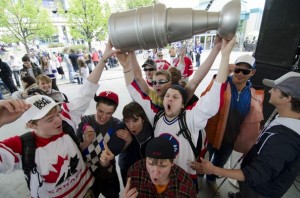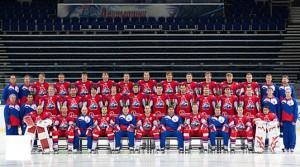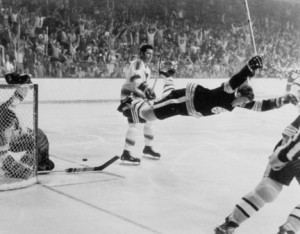by Jas Faulkner, senior correspondent
 One of the most popular, most quoted and most parodied promotional campaigns ever launched by the NHL is the series of ads that start running in late Winter and wind down sometime around the cusp of Summer when the Stanley Cup is raised and paraded around a rink somewhere in North America. The faces that appear in the montages as the signature piano noodling starts change every year, but one thing remains constant, the tagline:
One of the most popular, most quoted and most parodied promotional campaigns ever launched by the NHL is the series of ads that start running in late Winter and wind down sometime around the cusp of Summer when the Stanley Cup is raised and paraded around a rink somewhere in North America. The faces that appear in the montages as the signature piano noodling starts change every year, but one thing remains constant, the tagline:
“History Will Be Made”
You’ll get no argument from me that history is made every year around that time. A new feel-good story emerges, a long drought ends, cities are, for better or worse, moved to action by what happens during the playoffs. But you don’t have to wait for the postseason to see important events in the life of the game. History is being made right now. Important milestones in the growth of this game are happening on the ice, in the stands and in offices all over the continent. It is, in part, due to plain old zeitgeist. Technology allows us to watch hockey wherever, when ever we want. The emerging, no, burgeoning social media makes nearly every development known, sometimes as it is happening.
Hockey Reclaims Its Roots, Grows New Branches…
When Mark Chipman announced that Winnipeg was re-entering the NHL at 10:30 am on May 30th, the conservative estimate of people gathered at The Forks was around five thousand. Beyond the crowd celebrating on the ground were the millions who watched everything unfold via broadcast television and internet transmissions. The event illustrates the importance of the restoration of the NHL’s presence in Canada. What was evident on that day was the extent to which hockey is so vital to the country that still produces the majority of its talent and yet has lived with the spectres of departed teams and broken promises for the past two decades.
broadcast television and internet transmissions. The event illustrates the importance of the restoration of the NHL’s presence in Canada. What was evident on that day was the extent to which hockey is so vital to the country that still produces the majority of its talent and yet has lived with the spectres of departed teams and broken promises for the past two decades.
What happened in Winnipeg is more than the return of a pastime. It is the restoration of civic pride in something that is part of the history and tradition of the province. It is the renewal of family traditions. It is an homage to the people who made the memories of those games a part of Manitoban lore. On that day, in that city square, there were young men and women who could barely remember the Jets’ departure to Arizona. There were people who were there for the first iteration of the Jets and were lucky enough to be around for the team’s rebirth. There were also more than a few men and women wearing their parents’ or grandparents’ treasured sweaters to observe a time they thought would never come again. One thing that has made it all so grand is that anyone willing to pay attention is a part of this, even if just to bear witness to something so very right.

Hockey’s roots have deepened as its newest branches continue to grow outward. Recent drafts have revealed talent coming from unexpected locations. Legacy player Blake Geoffrion came up through the youth system in Nashville and continues the family tradition as a part of a young franchise far from his Grandfather’s beloved Habitants. Fresh talent from Southern California took the draft class by storm last year. It comes down to this: Hockey is growing. Sun belt hockey, often viewed by the rest of the continent as a cute anomaly, now boasts programs from SEC NCAA powerhouses such as Florida State, the University of Georgia and the University of Tennessee. Halifax and Moscow produced this generation’s phenomenal talents. The next bigger-than-life NHL heroes may very well originate from Athens, Georgia or Orange County, California.
The Boys Are Growing Up
Last Spring, the war of words between Theo Fleury and Vancouver’s fans was vituperative enough to cause the community to take a hard look at the discourse surrounding hockey. The language around the incident targeted an issue (pediatric sexual abuse in youth hockey) that had received little attention until Fleury’s disclosure. What happened had a polarising effect in some circles, but to many, it meant that the time had come for the hockey community to take a more deeply engaged approach to social issues.
While leagues at all levels have always devoted time and resources to worthy charitable efforts,
there was always an element of remove unless it was a specific cause that had touched the life of an individual player. Over the course of the last few months, professional hockey upped the ante when it came to socially responsible behaviour on and off the ice. In the latter half of last season, many teams made anti-bullying PSAs. Brian Burke marched in a Pride Day parade in support of his son. In the post-season, one of the NHL’s notorious problem children, Sean Avery, joined other prominent New Yorkers who expressed their support for gay marriage.
it came to socially responsible behaviour on and off the ice. In the latter half of last season, many teams made anti-bullying PSAs. Brian Burke marched in a Pride Day parade in support of his son. In the post-season, one of the NHL’s notorious problem children, Sean Avery, joined other prominent New Yorkers who expressed their support for gay marriage.
The mix of consternation and support for Avery was soon overshadowed by the deaths of a trio of NHL enforcers. As fragile off the ice as they were feared on it, their deaths serve as a signal that it is time to rein in the bread and circuses aspect of hockey. Veterans, pundits, fans, players, league wonks and owners are moving beyond the usual toothless debate about the dangers of the sport. This Autumn, some former players, including a veteran enforcer turned lawyer, made it clear that the bully-boy tactics used to shut down serious discussion of the long-term effects of the physical damage incurred on the ice were no longer acceptable.
Negative rhetoric from the usual suspects comes as no surprise, but neither are the heroic efforts to fly in the face of entities with so much to gain by keeping the escalating brutality that piths the sport of its humanity. The men and women who have taken on this fight are asking everyone to rethink hockey. Beyond the beatings is a game that is no less physical and has the craft of play that requires a full investment of each player’s body, mind and spirit without exacting the cruel price of forfeiting a fulfilling life off the ice. Even though you may not realise it yet, what you are seeing is the start of something good. Those men and women are formenting a revolution within the sport.
Hearts and Minds Prevail as the Game Becomes Even More Borderless

The mettle of the global hockey community was tested this summer. Worldwide response to the tragedy that took the lives of the KHL’s Yaroslavl Lokomotiv was immediate and deeply compassionate. Shaken in a manner and scale as we had never been shaken before and unified by our love of the game, hockey -as a tribe, as a people, as a family- came together. As a collective, we, the hockey community have grieved the loss. Afterwards, we remained engaged to see that the families of those 44 men were held up by charitable efforts towards their continued care and support. The survivors of the Lokomotiv are not a faintly remembered unfortunate footnote, they are family and they are our concern.
Being In The Present
Every now and then someone asks for a first or favorite hockey memory. When I mention that my earliest hockey memory is sitting with my father in our den, watching Bobby Orr’s flying goal on our black and white television, many people express envy of my six-year-old self. It is a pretty sweet memory, being enfolded in my fathers arms that seemed so big at the time, gasping as he cheered at the flying man and the celebration that exploded on the ice and in the stands seconds later.
earliest hockey memory is sitting with my father in our den, watching Bobby Orr’s flying goal on our black and white television, many people express envy of my six-year-old self. It is a pretty sweet memory, being enfolded in my fathers arms that seemed so big at the time, gasping as he cheered at the flying man and the celebration that exploded on the ice and in the stands seconds later.
My Orr memory is someone else’s Gretzky memory, which down the line will be someone else’s Ovechkin memory. They can only exist as magical moments for the people who were where they were in life when they happened. The present is no less magical. There is so much to be optimistic about when it comes to hockey. The golden age is contained in the moment when you’ve drawn your latest breath. The best time is now.